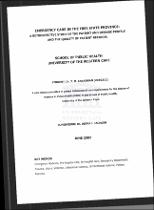| dc.description.abstract | The national and provincial governments of South Africa are busy restructuring Emergency Care, which enjoys frontline pivotal role in its health care delivery system. Research on Emergency Care is very limited locally and this study does a baseline situational analysis in the hope of stimulating further research. OBJECTIVES include the measurement of patient and disease profile of emergency room visits, salient features of trauma/violence patients, quality of care and quality of records and utilization of service by the community. METHOD: This cross-sectional retrospective study uses multistage stratified random sampling and the principle of probability proportional to sample size of the patient records. Trauma profile: Accidents (40%) and violence (40%) constitute major cause with traffic accident 10%. Most accidents
occur in home and its surroundings in the form of accidental fall. Interpersonal violence (82%) is the common form of violence but the woman-child-elderly abuse is surprisingly low. Quality of records is generally poor. Most components of the records are around 40%
compliant and theatre and discharge records are around 10% compliant. Analysis of association of variables such as waiting time, quality of record and emergency status to other variables in the study does not reveal .~any significant relations. Few associations detected are: (a) quality of records improves with longer waiting time, (b) Medical patients are more likely to be a child, get a laboratory test and gets discharged after treatment and (c) relatively more ma le patients visit emergency room for real emergency conditions. CONCLUSIONS: The study unravels many areas of emergency care in Free State that can be improved. Non-emergency patients frequently treated in ER. There is room for improving access to service, preparedness, service organization, integration of pre-hospital and in hospital care and emergency care systems. Several recommendations regarding policy development and areas/topics for further research are listed. | en_US |

